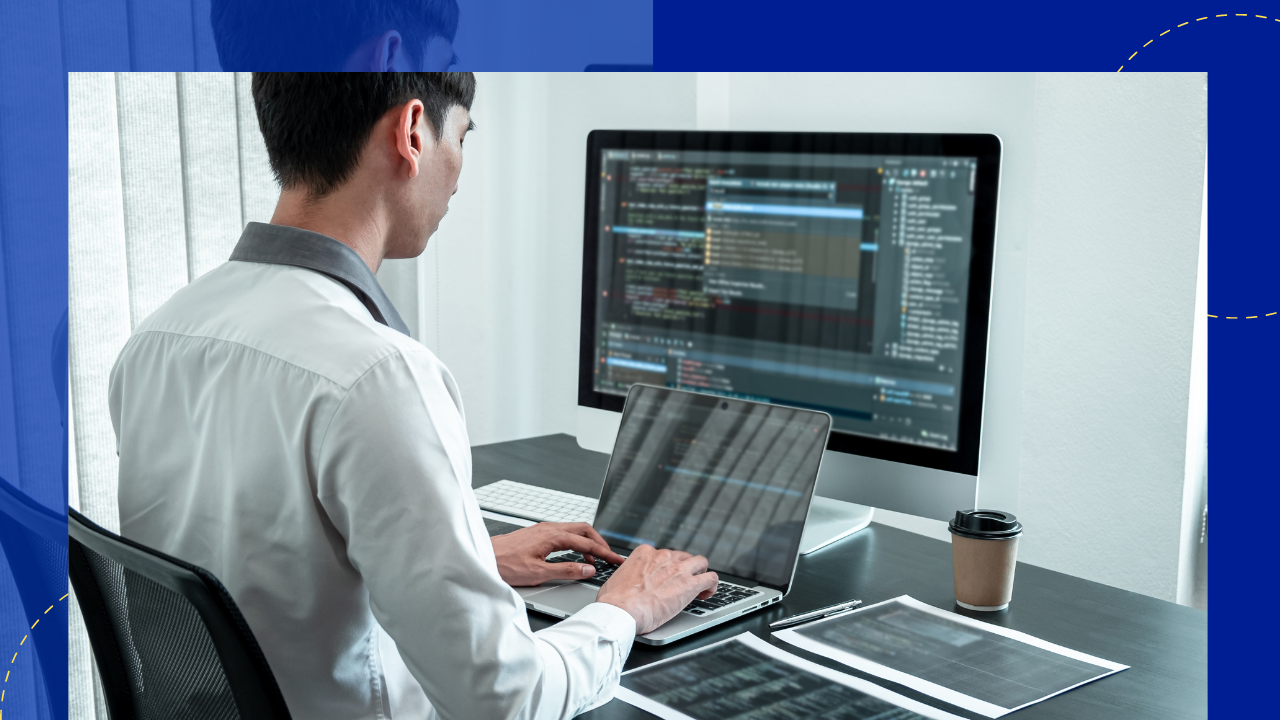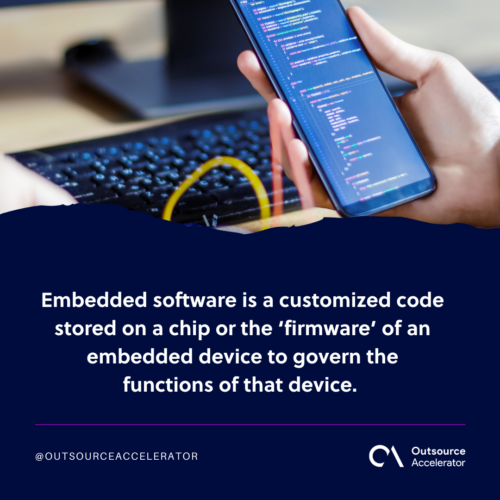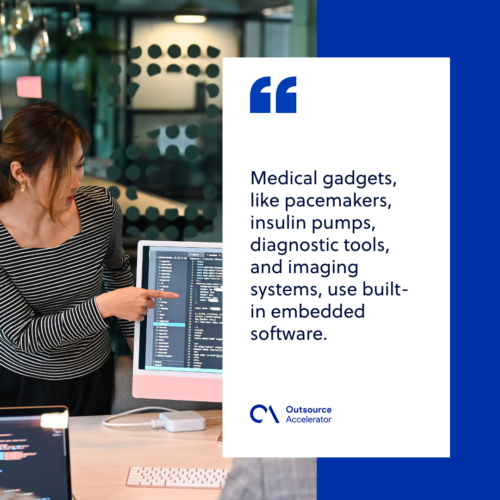Embedded software: What it is and why it matters

Embedded software is critical in current technology because it allows devices and systems to operate effectively and accomplish specialized functions.
This blog article discusses embedded software, its types, applications, and importance.
Definition of embedded software
Embedded software is a customized code stored on a chip or the ‘firmware’ of an embedded device to govern the functions of that device. Hardware manufacturers often use this to control the functionality of various devices and systems.
This software manages the functionality of software applications installed on a computer and the operating system.
Users often do not interact directly with embedded software since it does not require input. But embedded software may be found in almost any item, such as toasters and light bulbs — to more intricate tracking systems in missiles.

5 types of embedded software
Here are the five types of embedded software — each serving different purposes:
Real-time embedded software
Real-time embedded software aims to create applications that can react to events or inputs while adhering to strict time limits.
It is necessary for embedded software to process the input and provide the output within the time constraints to guarantee that the system will operate effectively.
Applications like robotics and flight control systems frequently use real-time embedded software since these programs must respond promptly and consistently.
Firmware
Firmware is embedded software permanently stored in a device’s non-volatile memory, generally in read-only memory (ROM) or flash memory.
ROM and flash memory are both examples of non-volatile memory. It offers low-level control over the device’s hardware and lets it carry out various specialized duties.
Devices such as smartphones, routers, and Internet of Things (IoT) devices often have some kind of firmware, ensuring that the hardware components function as intended.
Moreover, firmware typically gives control of the device to an operating system, which then launches and manages the programs the device utilizes.
Middleware
The middleware is a connection point within embedded software between the application and hardware components.
It adds a layer of abstraction, simplifying the development process and making it easier for different components to communicate and interact.
Embedded systems frequently use middleware since these systems require networking, data management, or complicated software structures.
Device drivers
Device drivers are embedded software components facilitating communication between an embedded system’s operating system and the connected hardware devices.
This component facilitates communication between the operating system and peripheral devices such as printers, displays, sensors, and actuators.
Device drivers ensure proper device operation and grant software access to the device’s features.
BIOS and bootloaders
The Basic Input/Output System (BIOS) and bootloaders are the embedded software components responsible for initializing the hardware and loading the operating system.
Bootloaders manage the process of loading an operating system into the device’s memory. Meanwhile, the BIOS controls fundamental system tasks such as hardware initialization and the system’s setup.
These two embedded software components are essential to the system’s initialization and ongoing functionality.
Applications of embedded software
How do you apply embedded software to your operating system? Here are a few examples:
Automotive industry
Embedded software is responsible for controlling various operations in the car sector. These include engine management, safety systems, entertainment systems, and navigation.
It makes it possible to integrate advanced driver assistance systems (ADAS) and is an essential component of self-driving automobiles.
Consumer electronics
Consumer gadgets all run on embedded software, including:
- Smartphones
- Tablets
- Smart televisions
- Household appliances
Embedded software enables functionality for user interfaces, connection, multimedia, and smart features to work on these gadgets.
Medical devices
Medical gadgets, like pacemakers, insulin pumps, diagnostic tools, and imaging systems, use built-in embedded software. It makes sure that these gadgets work correctly and reliably so that doctors and nurses can give good care to their patients.

Industrial automation
Operating machinery, robotics, and process control systems in industrial automation systems rely heavily on embedded software.
It improves manufacturing and industrial productivity by facilitating process monitoring, data collecting, control algorithms, and human-machine interfaces.
Embedded software power-ups in modern technologies
Here are some of the power-ups of embedded software in modern technologies:
- Internet of Things (IoT) – the Internet of Things (IoT) is a system of interconnected computing devices that runs on embedded software. Some of the tasks embedded software regulates for IoT are: data gathering, processing, and communication.
- Artificial intelligence (AI) – data processing, pattern recognition, and decision-making are just some of the many tasks that AI systems’ embedded software manages. Robotics and self-driving cars also rely on it.
- Edge computing – this system uses embedded software to move processing and data storage closer to the point of usage. The edge devices’ processing, analysis, and communication capabilities are all under the embedded software’s command.
- Cybersecurity – security systems rely on embedded software to manage tasks, including data encryption, threat detection, and access management.
Overall, with the help of embedded software, machines can regulate the workings of the hardware. It controls the flow of resources and maximizes efficiency to guarantee dependable performance.
Looking to improve your systems with tailored embedded software solutions? Visit Innowise‘s website to explore how its expertise can help your business achieve greater efficiency and innovation.







 Independent
Independent




